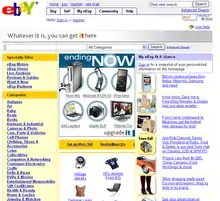Used good
Used goods mean any item of personal property offered for sale not as new, including metals in any form except coins that are legal tender, but excluding books, magazines, and postage stamps.[1]

Risks
Furniture, in particular bedding or upholstered items, may have bedbugs, if they have not been examined by an expert.[2]
Benefits
Recycling goods through the secondhand market reduces use of resources in manufacturing new goods and diminishes waste which must be disposed of, both of which are significant environmental benefits.Another benefit of recycling clothes is for the creation for new pieces of clothing from combings parts of recycled clothes to make a whole new piece. This has been done by multiple fashion designers recently and has been growing in recent years. However, manufacturers who profit from sales of new goods lose corresponding sales. Scientific research shows that buying used goods reduces carbon footprint and CO2 emissions significantly compared to the complete product life cycle, because of less production, raw material sourcing and logistics.[3] Often the relative carbon footprint of production, raw material sourcing and the supply chain is unknown.[4] A scientific methodology has been made to analyze how much CO2 emissions are reduced when buying used goods like secondhand hardware versus new hardware.[5]
Quality secondhand goods can be more durable than equivalent new goods.[6]
Types of transfers
Many items that are considered obsolete and worthless in developed countries, such as decade-old hand tools and clothes, are useful and valuable in impoverished communities in the country or in developing countries. Underdeveloped countries like Zambia are extremely welcoming to donated secondhand clothing. At a time when the country's economy was in severe decline, the used goods provided jobs by keeping "many others busy with repairs and alterations". It has created a type of spin-off economy at a time when many Zambians were out of work. The used garments and materials that were donated to the country also allowed for the production of "a wide range of fabrics" whose imports had been previously restricted. The trade is essentially executed by women who operate their small business based on local associations and networks. Not only does this provide self-employment, but it also increases household income and enhances the economy. But while many countries would be welcoming of secondhand goods, it is also true that there are countries in need who refuse donated items. Countries like Poland, the Philippines, and Pakistan have been known to reject secondhand items for "fear of venereal disease and risk to personal hygiene". Similar to these countries, India also refuses the import of secondhand clothing but will accept the import of wool fibers, including mutilated hosiery which is a term meaning "woollen garments shredded by machine in the West prior to export". Through the production of shoddy (recycled wool), most of which is produced in Northern India today, unused clothing can be recycled into fibers that are spun into yarn for reuse in "new" used goods.[7]
There has been concern that export of electronic waste is disguised as trade of used goods, with the equipment ending in poor-country waste dumps.,[8]

Types
Used clothing
In developed countries, unwanted used clothing is often donated to charities that sort and sell it. Some of these distribute some of the clothing to people on low incomes for free or at a very low price. Others sell all of the collected clothing in bulk to a commercial used clothing redistributor and then use the raised funds to finance their activities.[9] In the U.S., almost 5 billion pounds of clothing is donated to charity shops each year. Only about 10% of it can be re-sold by the charity shops. About a third of the donated clothing is bought, usually in bulk and at a heavy discount, by commercial dealers and fabric recyclers, who export it to other countries. Some of the used clothes are also smuggled into Mexico.[10]
Used clothing unsuitable for sale in an affluent market may still find a buyer or end-user in another market, such as a student market or a less affluent region of a developing country. In developing countries, such as Zambia, secondhand clothing is sorted, recycled, and sometimes redistributed to other nations. Some of the scraps are kept and used to create unique fashions that enable the locals to construct identity. Not only does the trade represent a great source of employment for women as well as men, but it also supports other facets of the economy: the merchants buy timber and other materials for their stands, metal hangers to display clothing, and food and drinks for customers. Carriers also find work as they transport the garments from factories to various locations. The secondhand clothing trade is central to the lives of many citizens dwelling in such countries.[7]
Importation of used clothing is sometimes opposed by the textile industry in developing countries. They are concerned that fewer people will buy the new clothes that they make when it is cheaper to buy imported used clothing. Nearly all the clothes made in Mexico are intended for export, and the Mexican textile industry opposes the importation of used clothes.[10]
Electronics and Home appliance
Electronics usually are traded as second hand goods, and may represent a hazard if disposed off incorrectly. Many of them may still be used, despite they are sometimes outdated ( for example TV's. While people may buy a new O-LED, and dispose off an older LCD TV, if still functional, it can be sold, not disposed off). In case of electronics, older electronics ( like home audio equipment) may outlast new equipment. It is the same for some home appliances.
Design and Furniture
Design items and furniture are also seeing an increase in being traded as secondhand goods. With some designer items being sought after in marketplaces. When trading design furniture and items you usually must be aware of the original retail price as most of the goods, if kept well, retain their value quite well.[11]
Other items
The Sierra Club, an environmental organization, argues that secondhand purchasing of furniture is the "greenest" way of furnishing a home.[12]
See also
- Atomic Ed and the Black Hole, a documentary film about a unique secondhand shop
- Auto auction
- Car boot sale
- Flea market
- Freeganism
- Regifting
- Recommerce
- Rebag
- Regiving
- Reseller
- Secondary market
- The RealReal
- Fashionphile
- The Market for Lemons, a book discussing a phenomenon that may make it difficult to maintain quality in markets for certain used goods, such as computers and cars
References
- "Used goods Definition".
- "What you need to know about bed bugs". msnbc.com. 20 March 2006. Retrieved 15 October 2020.
Do not buy used furniture (especially bedding items or upholstered items) ... until inspected carefully for any signs of bedbugs
- Krikke, Harold (1 October 2011). "Impact of closed-loop network configurations on carbon footprints: A case study in copiers". Resources, Conservation and Recycling. 55 (12): 1196–1205. doi:10.1016/j.resconrec.2011.07.001. Retrieved 25 May 2018.
- Krikkle, H.R. (2011). "How to reduce your company carbon footprint by reuse". Durabuilt. Archived from the original on 19 August 2014. Retrieved 7 October 2020.
- "News and analysis: Greener Network Calculator suggests benefits of re-using IT software". Carbon Management. 2 (3): 219–221. June 2011. doi:10.4155/cmt.11.29. S2CID 220269740. Archived from the original on 23 January 2013. Retrieved 7 October 2020.
- LaBrecque, Sarah; Gould, Hannah (28 November 2014). "Buying secondhand: an alternative to rampant consumerism of Black Friday". The Guardian. Retrieved 25 May 2018.
- Hansen, Karen Tranberg (August 2004). "Helping or hindering? Controversies around the international second-hand clothing trade". Anthropology Today. 20 (4): 3–9. doi:10.1111/j.0268-540X.2004.00280.x. Retrieved 15 October 2020.
- Grossman, Elizabeth (10 April 2006). "Where computers go to die – and kill (4/10/2006)". Salon.com. Retrieved 8 November 2012.
- "Old duds, big bucks; Clothes you think you're donating to charity are frequently sold for profit". Toronto Sun. 11 January 2007. Archived from the original on 24 October 2007. Retrieved 15 October 2020.
- Guo, Eileen (13 March 2018). "Here's What Really Happens to Your Used Clothes". Racked. Retrieved 15 October 2020.
- "Himassa Seconhand Design".
- "Green Your Rental - Eco Furnishings - The Green Life". Sierraclub.typepad.com. 2008-09-30. Retrieved 2012-11-03.